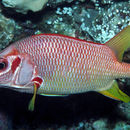Diagnostic Description
provided by Fishbase
Head and body red, scale edges silvery white; spinous dorsal crimson in color; other fins orange-yellow; vertically oblong crimson spot on preopercle behind eye (Ref. 4201). Five oblique scale rows on cheek; body depth 2.4-2.6 in SL; head length (HL) 2.55-2.85 in SL; lower jaw when closed slightly to moderately projecting; snout length 3.0-3.8 in HL larger than orbit diameter in adults; interorbital width 6.3-8.7 in HL; maxilla extending posteriorly to a vertical at front edge of the orbit; anterior end of nasal bone often with 2 close-set, short spines; medioposterior margin of nasal bone spineless; large nasal fossa spineless on margin; slight ridge of upper edge of suborbital bones weakly serrate; 2 subequal opercular spines; long preopercular spine, usually greater than orbit diameter in specimens at least 20 cm SL; 3rd or 4th dorsal spine longest, 1.7-2.3 in HL; 3rd anal spine 1.7-2.3 in HL (Ref. 27370).Description: Characterized by having 5 oblique scale rows on cheek (Ref. 90102).
- Recorder
- Cristina V. Garilao
Morphology
provided by Fishbase
Dorsal spines (total): 11; Dorsal soft rays (total): 14 - 16; Analspines: 4; Analsoft rays: 9 - 10
- Recorder
- Cristina V. Garilao
Trophic Strategy
provided by Fishbase
Inhabits rocky and coral reefs (Ref. 9137, 58534). A solitary species that inhabits a variety of reef zones from reef flats to lagoon and seaward reefs to a depth of at least 122 m and is fairly common in areas not subjected to heavy spear fishing. Found under ledges during the day (Ref. 9710). Juveniles inhabit shallow protected reefs. A nocturnal species that feeds on crabs, shrimps and small fishes.
Biology
provided by Fishbase
A solitary species that inhabits a variety of reef zones from reef flats to lagoon and seaward reefs to a depth of at least 122 m and is fairly common in areas not subjected to heavy spear fishing. Found under ledges during the day (Ref. 9710). Benthopelagic (Ref. 58302). Largest species of squirrelfish and the highest-bodied Sargocentron (Ref. 37816). Juvenile inhabits shallow protected reefs. A nocturnal species that feeds on crabs, shrimps and small fishes. Spine of preopercle venomous. Largest squirrelfish (Ref. 48635).
Importance
provided by Fishbase
fisheries: minor commercial; aquarium: public aquariums; price category: medium; price reliability: very questionable: based on ex-vessel price for species in this family
分布
provided by The Fish Database of Taiwan
分布於印度-太平洋區,西起紅海與東非到夏威夷與迪西島,
北至日本南部,
南至澳洲。臺灣各地及離島的礁區皆可見。
利用
provided by The Fish Database of Taiwan
一般以一支釣及延繩釣的方法捕獲。魚肉白,但質地較爛,煮湯時肉易散開且多溶解油質,因此適合抹鹽油煎食用。唯須注意其內臟可能累積熱帶海魚毒。而它的鱗片及棘刺尖利,需小心刺傷。在水族館中也有人看上它鮮紅的體色,將它飼養做為觀賞魚。
描述
provided by The Fish Database of Taiwan
體呈橢圓形,中等側扁。頭部具黏液囊,外露骨骼多有脊紋。眼大。口端位,裂斜。下頜些微突出於上頜。前上頜骨的凹槽大約達眼窩的前緣稍後方;鼻骨的前緣圓形;鼻窩沒小刺。鰓蓋骨具2棘;前鰓蓋骨後下角具ㄧ強棘;眶下骨於上緣略微鋸齒狀
。體被大型櫛鱗;側線完全,側線鱗數
41-47(43-45),側線至背鰭硬棘中間點之鱗片數 3.5;頰上具 5
列斜鱗。鰓耙數5-7+11-13=17-20。背鰭連續,單一,硬棘部及軟條部間具深凹,具硬棘
X-I,軟條
14-16(15),硬棘鰭膜上緣凹入;最後一根硬棘短於前一根硬棘。臀鰭有硬棘
IV,軟條 9-10(10);胸鰭軟條 15
;尾鰭深叉形。頭部與身體紅色,鱗片邊緣銀白色。背鰭的硬棘部鰭膜深紅色,餘鰭橘黃色的;眼後方的前鰓蓋骨上有一垂直長方形的深紅色斑點。
棲地
provided by The Fish Database of Taiwan
尖吻棘鱗魚棲息的地方非常多樣化,幼魚期棲息於水淺且易躲藏行跡的礁石邊,長大後移居到水較深的地方,深度可達122公尺以上,不論是礁石區或礁台、礁湖或向海的礁坡,都可見其蹤跡。白天獨自躲在洞穴中休息,或徘徊在家門附近的暗礁之外,夜晚則出外覓食,以蝦蟹之類的甲殼動物或小魚為主要食物。
Description
provided by World Register of Marine Species
Inhabits a variety of reef zones from reef flats to lagoon and seaward reefs to a depth of at least 122 m and is fairly common in areas not subjected to heavy spearfishing. Juveniles inhabit shallow protected reefs. A nocturnal species that feeds on crabs, shrimps and small fishes. Spine of preopercle venomous.
Froese, R. & D. Pauly (Editors). (2023). FishBase. World Wide Web electronic publication. version (02/2023).
- license
- cc-by-4.0
- copyright
- WoRMS Editorial Board

